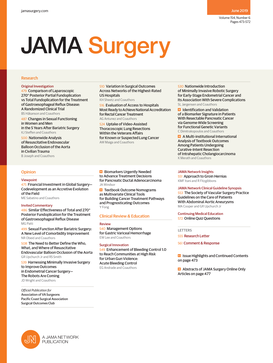钠-葡萄糖共转运蛋白2抑制剂使用者的术后预后。
IF 15.7
1区 医学
Q1 SURGERY
引用次数: 0
摘要
病例报告和小型回顾性研究表明,术前使用钠-葡萄糖共转运蛋白2抑制剂(SGLT2i)的患者术后正常血糖酮症酸中毒(eKA)和急性肾损伤(AKI)的风险增加。然而,在接受手术的患者中,还没有对这些药物的风险进行有代表性的评估。目的评价术前长期使用SGLT2i者与未使用SGLT2i者术后eKA、AKI和术后30天内死亡率的风险。设计、设置和参与者这是一项多中心、倾向匹配、回顾性病例对照研究,来自退伍军人事务卫生保健系统(VAHCS)国家登记处,研究时间为2014年1月1日至2022年12月31日。术前使用SGLT2i并接受住院外科手术的成年患者与1:5匹配的对照组进行倾向评分匹配,包括患者的人口统计学特征、合并症和手术特征。数据分析时间为2023年6月至2024年8月。暴露长期使用SGLT2i,定义为门诊处方超过3次或根据VAHCS药房登记的最后一次填充间隔小于180天。主要结局和测量主要结局是SGLT2i使用者与对照组患者的术后eKA发生率。次要结局包括术后AKI和术后30天死亡率。结果462例 968例手术患者中,SGLT2i使用者7448例(平均[SD]年龄67.7[8.1]岁;7204名[96.7%]男性)和455名 520名非使用者(平均[SD]年龄65.8[11.0]岁;424例 785例(93.3%)。倾向评分匹配后,7439例患者被确定为SGLT2i使用者,而对照患者为33例 489例。使用SGLT2i与eKA风险增加相关(优势比[OR], 1.11;95% CI, 1.05-1.17),但可降低围手术期AKI的风险(OR, 0.69;95% CI, 0.62-0.78)和30天死亡率(OR, 0.70;95% ci, 0.55-0.88)。SGLT2i使用者术后30天死亡率为1.1%,对照组为1.6%。eKA患者的住院时间中位数增加了3天(eKA患者的中位数[IQR]为6[3-10]天,无eKA患者的中位数为3[2-6]天)。结论及相关性SGLT2i治疗的患者术后eKA风险虽小但显著升高,但术后AKI和30天死亡率风险较低。本文章由计算机程序翻译,如有差异,请以英文原文为准。
Postoperative Outcomes Among Sodium-Glucose Cotransporter 2 Inhibitor Users.
Importance
Case reports and small retrospective studies have suggested that there is an increased risk of postoperative euglycemic ketoacidosis (eKA) and acute kidney injury (AKI) among patients using sodium-glucose cotransporter 2 inhibitors (SGLT2i) preoperatively. However, there has not been a representative assessment of the risks of these agents among patients undergoing surgery.
Objective
To evaluate the risk of postoperative eKA, AKI, and mortality within 30 days after surgery among preoperative long-term SGLT2i users compared with nonusers.
Design, Settings, and Participants
This is a multicenter, propensity-matched, retrospective case-control study from the Veterans Affairs Health Care System (VAHCS) National Registry performed from January 1, 2014, to December 31, 2022. Adult patients using SGLT2i preoperatively who underwent inpatient surgical procedures were compared with a 1:5 matched control group using propensity score matching, including the patient's demographic characteristics, comorbidities, and surgical characteristics. Data analysis was performed from June 2023 to August 2024.
Exposure
Long-term use of SGLT2i, defined as having more than 3 fills of outpatient prescription or less than a 180-day gap of the last fill according to the VAHCS pharmacy registries.
Main Outcomes and Measures
The primary outcome was the rate of postoperative eKA among SGLT2i users vs control patients. Secondary outcomes included postoperative AKI and 30-day mortality after surgery.
Results
Among 462 968 patients undergoing surgery, 7448 SGLT2i users (mean [SD] age, 67.7 [8.1] years; 7204 [96.7%] male) and 455 520 nonusers (mean [SD] age, 65.8 [11.0] years; 424 785 [93.3%] male) were identified. After propensity score matching, 7439 patients were identified as SGLT2i users and compared with 33 489 control patients. SGLT2i use was associated with an increased risk of eKA (odds ratio [OR], 1.11; 95% CI, 1.05-1.17) but reduced risks of perioperative AKI (OR, 0.69; 95% CI, 0.62-0.78) and 30-day mortality (OR, 0.70; 95% CI, 0.55-0.88). The mortality rate 30 days after surgery was 1.1% among SGLT2i users vs 1.6% among control patients. The median hospital length of stay among the patients presenting with eKA increased by 3 days (median [IQR], 6 [3-10] days for those with eKA vs 3 [2-6] days for those without eKA).
Conclusions and Relevance
Patients treated with SGLT2i had a small but significantly higher risk of postoperative eKA but lower risks of postoperative AKI and 30-day mortality.
求助全文
通过发布文献求助,成功后即可免费获取论文全文。
去求助
来源期刊

JAMA surgery
SURGERY-
CiteScore
20.80
自引率
3.60%
发文量
400
期刊介绍:
JAMA Surgery, an international peer-reviewed journal established in 1920, is the official publication of the Association of VA Surgeons, the Pacific Coast Surgical Association, and the Surgical Outcomes Club.It is a proud member of the JAMA Network, a consortium of peer-reviewed general medical and specialty publications.
 求助内容:
求助内容: 应助结果提醒方式:
应助结果提醒方式:


